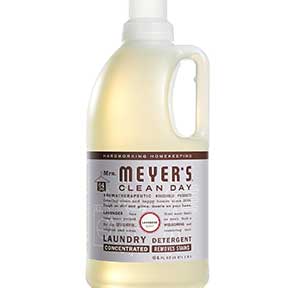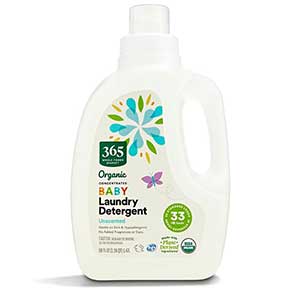Laundry 101: Part 5 – Using Laundry Detergent

Everything Your Mom Didn’t Tell You about Laundry Detergents
When choosing a laundry detergent, check the appliance manufacturer manual for the best type of detergent to use in your washing machine.
Many new washing machines require HE (high efficiency) detergent in order to properly clean and rinse the soap out of your clothing. HE detergent is low sudsing and stops excess suds from forming in front loading washing machines. Other than HE detergent, the detergent you choose really depends on your own preferences; powder versus liquid, brand, scent and budget.
Use the Right Amount of Detergent, Don’t Overdo It
You’ll be much more satisfied with your washing machine, and the way your clothes turn out, if you read detergent instructions, you’ll find that more detergent is not better. If the detergent bottle says to use a half a capful for a regular load, then do not use a full cap of detergent.
The extra cleaning detergent you add will not get your clothes any cleaner. As a matter of fact it will be harder to rinse out of clothing. Detergent left on your clothing after they have been washed is ultimately just the same as dirt.
If you have a top loading washing machine that does not have a dispenser for detergent, let the tub start filling with water first then about half full add in the detergent so it can adequately mix then add in clothes.
Adjust Detergent for Water Hardness and Soil Level
It’s important to pay attention to the soil level, load size, and water hardness.
Soft Water
Soft water generates more suds naturally than the same amount of suds that would be generated in hard water. Avoid over sudsing which causes extended cycle times. If you know you have soft water, reduce the amount of detergent you use.
Hard Water
Hard water reduces detergent effectiveness which can result in poor cleaning of the clothes you are washing. Soften the water if needed to increase the power of the detergents used to wash clothes.
Soiled Clothing
Heavily soiled clothing should be allowed to pre-soak before washing as this allows stains and grime to loosen and be removed more easily. This can make a big difference in how they come clean.
Either fill the washing machine, a utility sink or bucket (depending on how many clothing items you are trying to get clean) with warm water, stain remover of your choice and detergent. Let soak overnight if you can.
Don’t Overload the Washing Machine
Don’t overload the washing machine! If you are overloading and packing clothes in tight, clothes do not have room to agitate which means they are not getting clean.
Overloading a washing machine also means that zippers, latches, buttons can rub up against another item of clothing and cause damage.
Overloading the washer can cause damage to the machine. With all the extra weight, it can strain the motor and you may have to have it repaired.
Front Loading Washing Machines and HE Detergents
Front loaders are designed to use less water (about 1/4 less) than that of regular top loading washing machines. It’s important to use HE (high efficiency) detergent in front load washing machines as the manufacturers recommend.
High efficiency detergents contain suds suppressors which reduce or eliminate suds without reducing the detergent effectiveness. When less suds are produced, the load tumbles more efficiently in a front loader and the cleaning results are maximized.
Using regular laundry detergent in a front loader will cause too many suds for the amount of water in the machine. Because front-loaders use less water in every load, this means the washing machine will have to work harder to get rid of all of that soapy sudsy water. Excess suds interfere with the agitation and tumbling action that is necessary to thoroughly remove dirt.
Some people try to use regular laundry soap in a front loader, but it’s not worth it. High efficiency means it cleans well with fewer suds. Using half the recommended amount of “regular” laundry soap is just not effective. The amount of suds may be cut down, but so is the cleaning power because you are using too little soap. It’s a catch-22 and is totally not worth it in the long run.
Just use HE detergents that are recommended for front loading washing machines and use the recommended amount to avoid soap build up.
Using Powdered Laundry Detergents
Generally powdered laundry detergents are more powerful than liquid detergent because bleach and detergent surfactants last longer and are more stable in powdered form.
It’s important to use warm or hot water when washing with powdered laundry detergent to completely dissolve it. Cold water can leave soap powder (that never dissolved) on your clothes and inside your washing machine and that residue is just waiting to start smelling everything up.
Using Liquid Laundry Detergents
Water temperature is not as much of a problem with liquid detergent because the detergent is already dissolved.
Liquid detergent is also beneficial if you have hard water. The high mineral content in hard water makes it more difficult for laundry soap to dissolve, so using a liquid detergent is the better choice.
Because liquid detergent is fairly concentrated, it’s just as easy to use too much. Liquid detergent also leaves a residue so it’s important to measure the amount you use in each load. The proper amount to use will vary depending on the load size and water level.
Look at the instructions on the back of the bottle and you’ll often find instructions to fill the cup just to the half way mark for a full wash load. I wonder how many people fill it 3/4 full or more without even knowing they are using 50 percent more than they should be?
Hopefully this reference on using laundry detergents has helped, now let’s move on to Laundry 101: Part 6, Using Fabric Softeners.
Clothing and Laundry



















